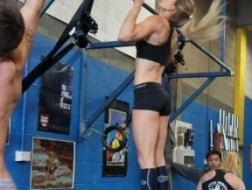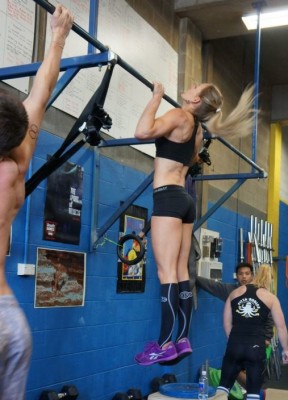Perfect your pull up and build a strong back.

I think the pull up is quite possibly the ultimate measure of upper body strength. It’s also an awesome back and arms strength building exercise. I’ve heard it referred to as the upper body “squat”, in terms of how important an exercise it is. It is, to the upper body, what squats are to the lower body. You’ll experience amazing strength gains from doing pull ups and build yourself a pretty impressive back while you are at it. Because you are moving your body through space, the level of neuromuscular activation is dramatically increased. It’s also a very impressive movement as it’s a challenging exercise. You might be able to squat your bodyweight or bench press your bodyweight, but can you pull up your body weight? The pull up measures your strength to weight ratio better than almost any other exercise known to man.
My pull up story
Pull ups hold a very special place in my heart. I absolutely love them! I am good at anything involving pulling my own bodyweight up, and I enjoy all type of pulling movements, but it wasn’t always that way. I owe much of my success to my boyfriend who helped me develop a good back and become very strong in pull ups.
When I started dating him I told him one of my fitness goals was to be able to do unassisted pull ups. To me, there is something extra awesome about seeing a chick bust out unassisted pull ups. He decided that every time we would train together he would add pull ups in between every exercise and every set we were doing. So if we were doing squats, in between each set we would do, say 10 pull ups. If we were doing bench press, in between each set we would go straight to the pull up bar and do a bunch of pull ups. And he would not let me cheat with them. If I had 4 pull ups left, even if I could only do 1 at a time, he would make sure I got through all 4. He has also always been a stickler for doing exercises with their proper range of motion. And he does textbook perfect pull ups, so I learnt well.
Within about three months of dating him I was doing full range pullups on my own. And I’ve only gotten better and better at them since then. Now I can do high rep sets of pull ups; I can pump out weighted pull ups, and I can do more advanced pulling movements like no-legs rope climbs and muscle ups, etc.
[caption id="attachment_139" align="aligncenter" width="507"] Me, pumping out high rep pull ups at a recent CrossFit Competition[/caption]
Me, pumping out high rep pull ups at a recent CrossFit Competition[/caption]
Progressions and working towards your first pull up:
So, what tips and pointers can I offer from my experience? Well for starters, my boyfriend took me off the assistance machine, which I had been using for years. Granted by this point in my training, I was only using a little bit of assistance on the machine anyway, but I believe getting off the assistance machine altogether, and using other progression methods took me out of my comfort zone/pull up plateau and played a huge role in my quick progress.
I just want to clarify that there is a difference between pull ups and chin ups. Pull ups are when your palms are facing away from you. You tend to use your lats more when you perform pull ups. The term “chin up” refers to the version when your palms are facing towards you. The chin-up has more bicep involvement, which is why many people find chin ups easier than pull ups and that can be a good place to start, but I personally think it’s important to not neglect learning a full proper pull-up. Chin ups are great as well, but there’s nothing quite like what pull ups will do for your back development.
If you are a complete beginner, start with just getting comfortable hanging from the bar (without completely locking out your elbows). This is a big step. It’s hard work just to hang. It will strengthen your forearms and grip in a big way. Then once you feel a little stronger just hanging on the bar, you can start adding jumping pull ups and negative pull ups.
I’m including a video of these different progressions. For negative pull ups, hang on to the bar and jump up to the top till your chin is over it. Once you're at the top, lower yourself down as slowly as possible (take about 5 seconds to lower yourself). At first, you will find it hard to slowly lower yourself down, but gradually you will be able to build up to lowering yourself in about 5-10 seconds. Do a few sets of these every time you train your back.
http://www.youtube.com/watch?v=KLefpQbSDFM&feature=plcp
You can also do assisted pull ups with bands. I recommend getting a few different sized resistance bands. There are big advantages to assisting with bands, instead of using the assisted pull up machine. They allow you to use your body’s natural range of motion and they require a lot more core stabilisation. The assisted pull up machine somewhat “cheats” you out of using your core and switching on your smaller stabliser muscles, which is a big part of developing the needing strength for doing pull ups. You can get different sized bands, and as you develop more and more strength in pull ups, you should challenge yourself further with thinner bands. Remember, you are going to have to work hard and be patient for that first pull up. It will take a lot of effort and consistency.
[caption id="attachment_136" align="aligncenter" width="500"] Different sized pull up bands[/caption]
Different sized pull up bands[/caption]
Once you reach the level where you can do at least one complete pullup without any assistance or jumping, you should modify your workouts. Start by doing as many unassisted pull ups as you can do and then use jumping pull ups or band assisted pull ups to complete the remaining reps you are aiming to complete in your sets.
Once you can do three to five complete pull ups without any assistance or jumping, you don’t need to continue to use assistance for them. This is when you should focus on increasing reps, adding in chin-ups, neutral grip and mixed grip pull ups, starting to do weighted chin-ups/pull ups etc.
Strengthen your grip and forearms.
The stronger your grip is in general, the easier pull ups will feel (and the better you will become at other exercises as well, like deadlifts). A lot of people have the upper body, back and bicep strength to do pull ups but they lack enough grip strength. You can do assistance exercises to strengthen your grip if this is a weakness for you.
Some of my favourite grip strengthening exercises are: Farmers walk holding heavy dumbbells or Kettlebells; plate pinching (this is done by setting up two or more plates smooth-sides-out and then lifting them off the floor in a pinch grip); towel pull ups (i.e, you can loop a towel over a bar and perform pull-ups), towel cable rows; weight plate bicep curls; rope training, etc.
[caption id="attachment_137" align="aligncenter" width="640"] Me, doing farmers walk, holding two 20 kg weight plates.[/caption]
Me, doing farmers walk, holding two 20 kg weight plates.[/caption]
Perfect your Pull up Form: Activate your lats.
One of the main points I teach clients when doing pull ups is to learn how to activate their lats properly. My cue for when they are in the dead hang position (before pulling up) is: shoulders down and chest up. So often I see people start their pull up in the dead hang position with their shoulders hunched up so high they’re touching their ears. That’s not the right way to start your pull up.
When you get on the bar and get into the dead hang position, you want to pull your shoulder blades down a bit and secure your shoulders into their sockets. This is a far safer position and makes sure that the stress will be placed in the right place and that your lats will be activated. Once you consciously practice this every time you do pull ups, it will start to become second nature for you.
How to activate your lats:
http://www.youtube.com/watch?v=V3HuyF27MCs
A proper pull up should be aiming to bring the elbows down towards the torso, as your chin goes over the bar. To feel your back working, imagine your arms as hooks and focus on pulling just the elbows down. Even though using proper form will be extra challenging in the beginning, it will make your pull ups so much stronger in the long run and prevent injuries and strains. Not only that, you will also get a killer v-shape back because the lats will start developing something fierce!
Add in assistance work to help out your pull ups:
Here are some good assistance back/arm/grip exercises you might find useful to add into your training program if you are struggling with doing your first pull up or struggling to get better at pull ups:
-Chin ups/mixed grip pull ups/neutral grip pull ups/towel pull ups
-Supine pull ups
-Wide grip Lat Pull Downs (these can be helpful especially for learning how to activate the lats.)
-DB/Cable Rows
-Bent Over Rows
-Face Pulls
-Bicep curls
Change up your rep ranges and grips for further progress!
Once you have your pull ups down pat, in order to continue progressing and increasing back strength, you should mix up your pull ups and other back exercises with a variety of rep ranges and grips.
A good thing I would suggest adding to your training is weighted pull ups (i.e. using a weight belt and attaching a kettlebell, or gripping a dumbbell or kettlebell with your feet) and doing weighted pull ups. Work towards sets of 5 reps with extra weight attached to you.
Other times you can do higher volume chin ups and pull ups. For a bit of a change up, bring out your resistance bands again and go for bigger hypertrophy sets. Try using different grips and bars such as: overhand, underhand, neutral grips, thick bars, skinny bars, narrow and wide grips. All of these things will continue to increase your pulling strength. Remember the principle of progressive overload. You can use this overload principle in so many different ways to keep progressing with pull ups.
Taking your pull ups even further:
Once you have mastered pull ups and want to try something even more advanced, you can add other harder pulling exercises to your repertoire. Things such as chest to bar pull ups, single arm pull ups, bar and ring muscle ups, rope climbs etc. Learning some new pulling movements can help you progress even further and will strengthen your back in new and different ways.
[caption id="attachment_141" align="aligncenter" width="960"] Ring muscle ups[/caption]
Ring muscle ups[/caption]
[caption id="attachment_140" align="aligncenter" width="960"] Me doing rope climbs at a recent CrossFit competition[/caption]
Me doing rope climbs at a recent CrossFit competition[/caption]
Hope this was helpful to any of you struggling to learn pull ups. If you have any questions about all of this feel free to drop me a note in the “contact me” tab.
Good luck with perfecting your pull ups and building a strong, fierce back! :)
Join the other 10,000+ who get my best fitness, diet & mindset tips.



Comments